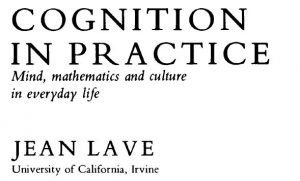Théories et pratiques de l’apprentissage situé 36/101

Cognition in practice 18/n

Cognition and practice
Introduction:
Ce billet se penche sur une section du Chapitre 6 du livre de Jean Lave « Cognition in Practice » dont l’intitulé est la The socially organized meaning of « math » – autrement dit, comment la société organise la signification des maths. Jean Lave, nous indique que le contenu cette section s’appuie sur les croyances des acteurs, telles que l’on peut les inférer de leur usage des maths dans un supermarché et de leurs réactions aux situations de test. Et elle qualifie son travail de « résumé impressionniste de conversations diffuses et d’observations plus décontractées »
« What follows does draw on their beliefs as these have been inferred from their uses of arithmetic in the supermarket and reactions to the testing situation. But in large part I am able to present only an impressionistic summary of diffuse conversations and observations of a more casual variety. »
The socially organized meaning of « math »
Pour Jean Lave, dans notre culture, à notre époque, les mathématiques sont un objet réifié, comme carrière, discipline académique ou corpus de connaissance. Pour les gens, c’est à la fois une discipline scolaire et un objet (les maths réelles)
« It appears that, in this culture at this time, mathematics is a reifled object as a career, academic discipline and body of knowledge. It is a subject in school and an object, « real math, » in folk belief. »
Les maths ont reçu leur forme et ont donné forme à un grand nombre de significations, valeurs et propriétés symboliques que les gens partagent…
« It has been given form by, and in turn has given form and substance to, a host of meanings, values, and symbolic properties which people share. Knowledge of math is taken to be a measure of sheer mental brilliance; it provides the kind of truth with which there is no possible argument, and is thus a technology of authority and the symbolic medium for asserting the authority of technology. It indicates exactitude, rationality and « cold » logic which stand in mutually exclusive relations with intuition, feeling, and expression. In short, its meanings as such are different from its instrumental and literal contents and meanings. »
Les mathématiques sont des vérités éternelles, … mais construites socialement
« Real math » in social practice is also « incorrigible(*) » in the terminology of phenomenological sociology. That is, part of the cultural meaning and value of mathematics comes from the strong supposition of its immutable reality (7 +5 = 12; a meter is a meter any time, any place). The Pythagorean Theorem is beamed into outer space because its « universal » properties recommend it as a form likely to be recognized by extraterrestrials. Arguments have been advanced, however, that these apparent eternal verities are socially constructed, »
Jean Lave présente la définition d’une « proposition incorrigible » par Poliner, par définition on ne peut pas admettre qu’elle soit fausse
Poliner quoting Gaskings begins with a definition:
* An incorrigible proposition is one which you would never admit to be false whatever happens happens: it therefore does not tell you what happens … The truth of an incorrigible proposilion … is compatible wilh any and every conceivable state of affairs. (For example: whaltever is your experience on counting, il is still true that 7 + 5 = 12)
Et tire les conséquences d’une notion d’incorrigibilité socialement construite: les théories cognitives, en particulier et l’éducation de manière omniprésente, ont soutenu et ont été soutenues par des hypothèses concernant les relations entre connaissance et pratique qui sont trop simples.
« If, as he argues, « incorrigibility » is constructed, then cognitive theory in particular, and schooling pervasively, have sustained and been sustained by assumptions about relations between knowledge and practice that are too simple. »
« Familiar relations between normative models and practice reflect these assumptions. Beliefs in one universal, unimpeachably true form of mathematics, applicable in canonical forms that themselves have no specific characteristics, meaning, or value, are direct expressions of the common cultural reifications of math. It seems difficult, if not impossible, to avoid such views if incorrigibility is assumed to be a natural property of mathematics rather than a social accomplishment. »
Mais si les mathématiques sont le produit d’une construction sociale, alors, les mathématiques en pratique sont plus ou autre chose que ce prétentent les praticiens et les professeurs. Par ailleurs, il a été montré que les relations quantitatives de sont pas confinées dans les limites mathématiques.
« But if « mathematics » is the product of social work and symbolic fashioning, surely math in practice is more and other than it is claimed to be by practitioners and teachers. Further, we have seen that quantitative relations are not confined within mathematical boundaries. »
Les analyses du précédent chapitre permettent d’argumenter le caracactère non déterminant de la structure des mathématiques dans la pratique
« The analysis of difference calculations in the previous chapter provided an empirical basis for arguing the nondeterminant structure of math in practice – that quantitative relations can have closer, more salient, relations to other kinds of relations than to each other. »
Dans ces circonstances, le signification symbolique des « maths réelles » est une ressource structurante qui aide à façonner l’activité
« Under these circumstances, the symbolic significcance of « real math » is a structuring resource that helps to shape activity. »
Certains aspects de l’activité quotidienne, dans la classe contribuent aux et reflètent les propriétés symboliques de l’arithmétique algorithmique
« Aspects of everyday activity in the classroom contribute to, as well as reflect, the symbolic properties and meanings of algorithmic arithmetic. »
Avec l’institutionnalisation « d’activités (pédagogiques) de résolution de problème »
« The properties of « formal » systems of money, measurement (and math) have been institutionalized in « problem-solving tasks » in school and in research on cognition. In school, money and measurement are addressed, perhaps exclusively, in arithmetic classes. »
Les leçons d’arithmétique en classe constituent un puissant lieu d’enseignement rationnel et utilitaire avec des messages implicites sur l’argent.
« Classroom arithmetic lessons provide a powerful locus for teaching rational, utilitarian interpretations of arithmetic, money and the standardized dimensions of material goods. In this context the transformation of relations of quantity is reduced to problem-solving procedures, that is, to means/ends relations. Children are taught the units and equivalents among units of currency and also about their relationship with the decimal notation system. This approach incorporates implicit messages that money, like arithmetic, is an objective system of units and relations with which to calculate. And since math and money, according to common belief, are objective and universal, when accurately applied they should produce correct, rational means for action. »
Et si vous doutez encore de la possibilité d’interprétation alternatives,… (re)lisez Karl Marx
« If in doubt about whether alternative interpretations are possible, contrast this characterization of money with its role as a fetishized object in Marxist theory. »
En bref…
En bref, les […] relations quantitatives sont transmises aux enfants à l’école, […] enseignées comme si elles n’avaient pas de valeur symbolique ou de connotations propres.
« In short, standard systematizations of quantitative relations are transmitted to children in school, specifically characterized as instrumental means to reach goals defined elsewhere, taught as if they had no symbolic value or connotations of their own.
Mais elles en ont, pourtant, …
et l’on pourrait s’attendre à les retrouver mobilisées comme ressources structurantes dans les pratiques mathématiques quotidiennes.
« But these are some of the central meanings and values ascribed to systems of quantity and their prescribed uses in this society. And we should expect to find them enacted, drawn upon as structuring resources, in everyday math practice. »
Billets précédents
Billet 1: Définitions de l’apprentissage situé
Billet 2: Pourquoi s’intéresser à la théorie de l’apprentissage situé?
Billet 3: Démarche et retour aux sources
Billet 4: Mai 1968 et l’apprentissage situé
Billet 5: Apprentissage situé et conversation
Billet 6: Lucy Suchman, mon téléphone portable et moi
Billet 7: Conversations avec moi-même (n° 1)
Billet 8: L’apprentissage situé mis en pratique, cela ferait quoi?
Billet 9: Contribution de la psychologie soviétique à la théorie de l’apprentissage situé
Billet 10: Les apports de la philosophie à la théorie de l’apprentissage situé
Billet 11: Focus sur l’école Dewey
Billet 12: Apports de la psychologie de la perception – la notion d’affordance
Billet 13: Apprentissage situé et intelligence artificielle, deep learning, réalité virtuelle, réalité augmentée, etc…
Billet 14: Conversations avec moi-même (N°2)
Billet 15: Quand John Dewey rencontre Jean Lave
Billet 16: Cognition in Practice (1/n)
Billet 17: Cognition in Practice (2/n)
Billet 18: Cognition in Practice (3/n)
Billet 19: Cognition in Practice (4/n)
Billet 20 : Cognition in Practice (5/n)
Billet 21: « Conversations avec moi même N°3 »
Billet 22: Cognition in Practice (6/n)
Billet 23: Cognition in Practice (7/n)
Billet 24: Cognition in Practice (8/n)
Billet 25: Cognition in Practice (9/n)
Billet 26: Cognition in Practice (10/n)
Billet 27: Cognition in Practice (11/n)
Billet 28: « Conversations avec moi-même N°4 »
Billet 29: Cognition in Practice (12/n)
Billet 30: Cognition in Practice (13/n)
Billet 31: Cognition in Practice (14/n)
Billet 32: Cognition in Practice (15/n)
Billet 33: Cognition in Practice (16/n)
Related Posts
« High Speed Coaching » et les 7 pourquoi
Théories et pratiques de l’apprentissage situé 9/101
Codéveloppement à haute vitesse 3/n
Articles récents
Archives
- mars 2024
- janvier 2024
- décembre 2023
- septembre 2023
- juin 2023
- avril 2023
- mars 2023
- janvier 2023
- octobre 2022
- septembre 2022
- juillet 2022
- mai 2022
- avril 2022
- mars 2022
- février 2022
- janvier 2022
- octobre 2021
- août 2021
- juillet 2021
- mai 2021
- février 2021
- juin 2020
- mai 2020
- avril 2020
- février 2020
- janvier 2020
- décembre 2019
- novembre 2019
- octobre 2019
- septembre 2019
- août 2019
- juillet 2019
- mai 2019
- avril 2019
- mars 2019
- février 2019
- janvier 2019
- décembre 2018
- septembre 2018
- août 2018
- juillet 2018
- juin 2018
- mai 2018
- avril 2018
- mars 2018
- février 2018
- janvier 2018
- décembre 2017
- novembre 2017
- octobre 2017
- septembre 2017
- août 2017
- juin 2017
- mai 2017
- avril 2017
- mars 2017
- février 2017
- janvier 2017
Catégories
- Actualités
- Adaptive Learning
- Allemagne
- Apprendre
- Apprentissage
- Branding
- Business
- Coaching
- Codeveloppement
- Communautés de pratique
- Deep learning
- Design
- Development
- E-Learning
- Ecole
- Education
- Europe
- Formation
- IA
- Intelligence articificielle
- LBC
- metacognition
- Non classé
- Orientation
- orientation
- Philosophie
- Poésie
- Réalité Augmentée
- Réalité Virtuelle
- Transition digitale
- WOL





Commentaires récents